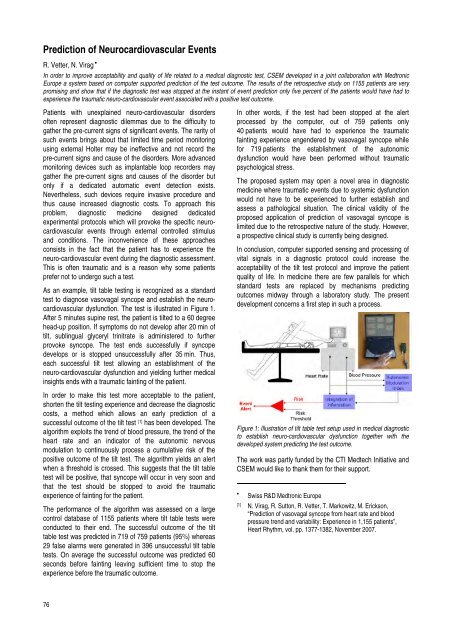research activities in 2007 - CSEM
research activities in 2007 - CSEM
research activities in 2007 - CSEM
You also want an ePaper? Increase the reach of your titles
YUMPU automatically turns print PDFs into web optimized ePapers that Google loves.
Prediction of Neurocardiovascular Events<br />
R. Vetter, N. Virag •<br />
In order to improve acceptability and quality of life related to a medical diagnostic test, <strong>CSEM</strong> developed <strong>in</strong> a jo<strong>in</strong>t collaboration with Medtronic<br />
Europe a system based on computer supported prediction of the test outcome. The results of the retrospective study on 1155 patients are very<br />
promis<strong>in</strong>g and show that if the diagnostic test was stopped at the <strong>in</strong>stant of event prediction only five percent of the patients would have had to<br />
experience the traumatic neuro-cardiovascular event associated with a positive test outcome.<br />
Patients with unexpla<strong>in</strong>ed neuro-cardiovascular disorders<br />
often represent diagnostic dilemmas due to the difficulty to<br />
gather the pre-current signs of significant events. The rarity of<br />
such events br<strong>in</strong>gs about that limited time period monitor<strong>in</strong>g<br />
us<strong>in</strong>g external Holter may be <strong>in</strong>effective and not record the<br />
pre-current signs and cause of the disorders. More advanced<br />
monitor<strong>in</strong>g devices such as implantable loop recorders may<br />
gather the pre-current signs and causes of the disorder but<br />
only if a dedicated automatic event detection exists.<br />
Nevertheless, such devices require <strong>in</strong>vasive procedure and<br />
thus cause <strong>in</strong>creased diagnostic costs. To approach this<br />
problem, diagnostic medic<strong>in</strong>e designed dedicated<br />
experimental protocols which will provoke the specific neurocardiovascular<br />
events through external controlled stimulus<br />
and conditions. The <strong>in</strong>convenience of these approaches<br />
consists <strong>in</strong> the fact that the patient has to experience the<br />
neuro-cardiovascular event dur<strong>in</strong>g the diagnostic assessment.<br />
This is often traumatic and is a reason why some patients<br />
prefer not to undergo such a test.<br />
As an example, tilt table test<strong>in</strong>g is recognized as a standard<br />
test to diagnose vasovagal syncope and establish the neurocardiovascular<br />
dysfunction. The test is illustrated <strong>in</strong> Figure 1.<br />
After 5 m<strong>in</strong>utes sup<strong>in</strong>e rest, the patient is tilted to a 60 degree<br />
head-up position. If symptoms do not develop after 20 m<strong>in</strong> of<br />
tilt, subl<strong>in</strong>gual glyceryl tr<strong>in</strong>itrate is adm<strong>in</strong>istered to further<br />
provoke syncope. The test ends successfully if syncope<br />
develops or is stopped unsuccessfully after 35 m<strong>in</strong>. Thus,<br />
each successful tilt test allow<strong>in</strong>g an establishment of the<br />
neuro-cardiovascular dysfunction and yield<strong>in</strong>g further medical<br />
<strong>in</strong>sights ends with a traumatic fa<strong>in</strong>t<strong>in</strong>g of the patient.<br />
In order to make this test more acceptable to the patient,<br />
shorten the tilt test<strong>in</strong>g experience and decrease the diagnostic<br />
costs, a method which allows an early prediction of a<br />
successful outcome of the tilt test [1] has been developed. The<br />
algorithm exploits the trend of blood pressure, the trend of the<br />
heart rate and an <strong>in</strong>dicator of the autonomic nervous<br />
modulation to cont<strong>in</strong>uously process a cumulative risk of the<br />
positive outcome of the tilt test. The algorithm yields an alert<br />
when a threshold is crossed. This suggests that the tilt table<br />
test will be positive, that syncope will occur <strong>in</strong> very soon and<br />
that the test should be stopped to avoid the traumatic<br />
experience of fa<strong>in</strong>t<strong>in</strong>g for the patient.<br />
The performance of the algorithm was assessed on a large<br />
control database of 1155 patients where tilt table tests were<br />
conducted to their end. The successful outcome of the tilt<br />
table test was predicted <strong>in</strong> 719 of 759 patients (95%) whereas<br />
29 false alarms were generated <strong>in</strong> 396 unsuccessful tilt table<br />
tests. On average the successful outcome was predicted 60<br />
seconds before fa<strong>in</strong>t<strong>in</strong>g leav<strong>in</strong>g sufficient time to stop the<br />
experience before the traumatic outcome.<br />
76<br />
In other words, if the test had been stopped at the alert<br />
processed by the computer, out of 759 patients only<br />
40 patients would have had to experience the traumatic<br />
fa<strong>in</strong>t<strong>in</strong>g experience engendered by vasovagal syncope while<br />
for 719 patients the establishment of the autonomic<br />
dysfunction would have been performed without traumatic<br />
psychological stress.<br />
The proposed system may open a novel area <strong>in</strong> diagnostic<br />
medic<strong>in</strong>e where traumatic events due to systemic dysfunction<br />
would not have to be experienced to further establish and<br />
assess a pathological situation. The cl<strong>in</strong>ical validity of the<br />
proposed application of prediction of vasovagal syncope is<br />
limited due to the retrospective nature of the study. However,<br />
a prospective cl<strong>in</strong>ical study is currently be<strong>in</strong>g designed.<br />
In conclusion, computer supported sens<strong>in</strong>g and process<strong>in</strong>g of<br />
vital signals <strong>in</strong> a diagnostic protocol could <strong>in</strong>crease the<br />
acceptability of the tilt test protocol and improve the patient<br />
quality of life. In medic<strong>in</strong>e there are few parallels for which<br />
standard tests are replaced by mechanisms predict<strong>in</strong>g<br />
outcomes midway through a laboratory study. The present<br />
development concerns a first step <strong>in</strong> such a process.<br />
Figure 1: Illustration of tilt table test setup used <strong>in</strong> medical diagnostic<br />
to establish neuro-cardiovascular dysfunction together with the<br />
developed system predict<strong>in</strong>g the test outcome.<br />
The work was partly funded by the CTI Medtech Initiative and<br />
<strong>CSEM</strong> would like to thank them for their support.<br />
•<br />
Swiss R&D Medtronic Europe<br />
[1] N. Virag, R. Sutton, R. Vetter, T. Markowitz, M. Erickson,<br />
“Prediction of vasovagal syncope from heart rate and blood<br />
pressure trend and variability: Experience <strong>in</strong> 1,155 patients”,<br />
Heart Rhythm, vol. pp. 1377-1382, November <strong>2007</strong>.








